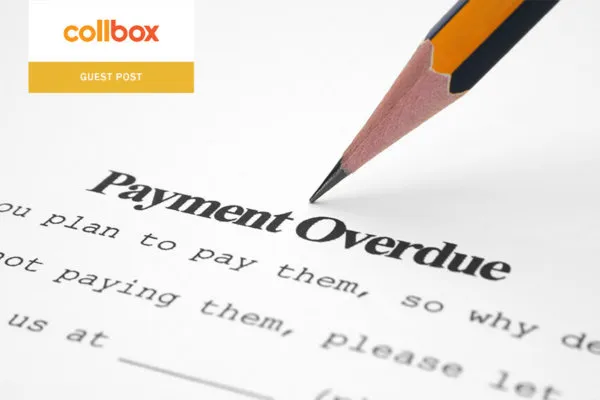Be hands-on when managing your business’ accounts receivables and understand when the right time is to flag collections.

According to a recent study, over 30% of small- to mid-sized businesses in North America currently experience issues (or expect to) with cash flow caused by late payments, that will negatively impact their ability to pay employees, suppliers and make forecasted company investments.
It may feel awkward to chase down your payments, especially from long-time clients and customers, but doing so will make it much more likely that you’ll get paid (and avoid the struggles listed above) in the long run.
Having a strategy in place around when and how you’ll collect on unpaid invoices (as well as what not to do) is the first step to success. Everything from the frequency, tone, and methods of communication used to contact your customers should change, the longer an invoice goes past due.
Read on to learn the components of an effective accounts receivable workflow and what to do at each step.
Table of Contents
1. When an Invoice Is Created
The best time to start collecting an invoice payment is well before it’s due. Think about it. How can you ever expect to be paid on time if you’re always waiting until after a payment is late to reach out to the customer?
Prompt invoice payment is much more likely if you set clear expectations with your customer up front. When you first create an invoice clearly state payment terms (the due date and payment methods you accept). You should do this both in the notes section of the invoice itself and in the body of the email you use to deliver the invoice.
This is also a great time to highlight any contingency terms you’d like to bring to the customer’s attention. For example, if a late fee will apply and compound every x number of days if the payment is late.
Any incentive for them to use one method of payment over another (like a discount if they pay via ACH rather than a credit card). It’s also a great place to call out that when an invoices ages to X (say 90 days) past due, it will be sent to collections.
Being upfront about your payment terms, and the actions that will be taken if they aren’t met is the best way to keep your clients aligned with your expectations and ensure your invoice get paid on time.

2. Before the Invoice Is Due
It is always a good idea to send a proactive reminder to your client a few days before their invoice is actually due. Set up a reminder for yourself or your team five to eight business days before the due date to resend the invoice, along with a gentle nudge, reminding them of the due date and payment terms.
Be sure to include a link to your online payment gateway or instructions to transfer you the balance owed, and let the client know you’re happy to accept payment now if they’d like to get it off their to-do list. Remember the easier you make it for your clients to pay the invoice, the more likely that they will!
3. The Day the Invoice Is Due
Don’t miss the opportunity to collect payment on time! If clients or customers know you routinely follow up for payment right away, they’ll become trained to know late payment will certainly be noticed, which is great for your business.
Re-send a copy of the invoice, along with a note that (kindly) reminds them about any late fees if the invoice that will incur if payment isn’t received on time. Make sure to let them know you’d prefer they reach out to you proactively if they anticipate not being able to make the deadline, rather than just go dark until the funds are available.
The more communication the better, especially when it comes to getting paid!
4. 7 Days Past Due
If your “day of” note goes unresponded to and the invoice goes 7 days (or 5 business days) past due, it’s time to follow up again.
This time try switching up the media. If you’ve been communicating payment expectations to them via email, try giving them a call. If you have the customer’s cell phone number, text messages are also proving to be a more and more effective way to communicate important information such as a missed payment—just don’t overuse it!
At this point in the collection timeline, you don’t want to make any assumptions about why you haven’t received payment. You know that they’re busy (heck, you’re busy) and how easy it can be for payment due dates to slip through the cracks, even when there are the best of intentions.
Get the method back on your customer’s radar in a fashion that stands out from your “standard” communication and it’s very likely you’ll receive payment (or at least a response) shortly thereafter. If another week goes by without communication, repeat this step when the invoice is around 15 days past due.
5. 30 Days Past Due
As soon as an invoice crosses the 30-day past due mark, it’s time to take a bit more of an aggressive approach. Make a phone call. If you reach them, great—ensure you get a firm commitment for the date they’ll send payment, and clearly explain what will happen next if that payment date isn’t met.
Even if you speak to the client directly follow up with all of that information outlined in an email to keep everyone on the same page, and ensure you have a written record of the conversation. Ask them to respond to the email to acknowledge that they’ve received it and agree to the terms.
If your phone call goes unanswered, or you get a voicemail—send them an email outlining the current state of their account and any existing or impending consequences that have/will affect their balance.
Make it clear you’ve attempted to contact them several times to no avail. They need to let you know if there are any outstanding issues holding up the payment of the account (such as missing information on your invoice, if the client is experiencing cash flow problems or if they are just disorganized). You’re still willing to work with them on a plan to get the account back in good standing—but it has to be a two-way street.
6. 45–90 Days Past Due
Once an invoice is 30 days past due, you should continue to follow up every 15 days. With each additional late payment notice, adjust the tone of your email to be sterner—not rude or threatening, just firm. You’re only stating the facts after all.
Continue to remind them of the consequences in terms they’ll understand, such as a delay of services or shipment of goods. Tell them whether their account will be placed on credit hold.
Remind them again about any late fees and the impending date they’ll be sent to collections if action isn’t taken. Continue to use multiple methods of communication (calls, emails, text messages) to draw their attention to your invoice and to create urgency.
7. 90 Days Past Due
After 90 days of consistent follow-ups and reminders on your part, if the customer has failed to make progress on the debtor communicate why there’s a delay in payment, it’s time to send them to collections.
The average business spends 15 days a year chasing down late payments! You’re far too busy for that, and you’ve already invested enough of your valuable time trying to get this customer’s attention. Reach out to a collection agency that you trust and that has a proven track record of successfully collecting on this type of account.
If you don’t already have a vetted agency who specializes in debt recovery for your industry, create a free CollBox account to get matched with one within minutes!

Written by Cameron Desautels, CEO & Co-Founder, Collbox
Posted on March 13, 2019

 Fight Your Fear of the Collections Process
Fight Your Fear of the Collections Process Roundup: Best Practices for Managing Cash Flow
Roundup: Best Practices for Managing Cash Flow Ghosted: What to Do When a Client Doesn’t Pay Up
Ghosted: What to Do When a Client Doesn’t Pay Up





